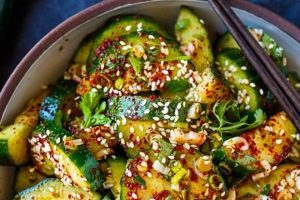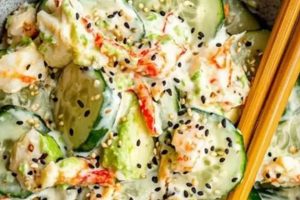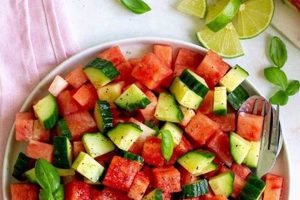A refreshing and light dish, typically composed of sliced cucumbers and apples, often combined with additional ingredients such as herbs, nuts, or cheeses. Variations may include sweet or savory dressings and incorporate diverse textures for added complexity. A simple example features thinly sliced cucumbers and apples tossed with a light vinaigrette, fresh dill, and toasted walnuts.
This type of salad offers several nutritional advantages. Cucumbers provide hydration and are a good source of vitamins K and C. Apples contribute fiber and antioxidants. The combination creates a dish low in calories and high in nutrients, making it a healthy addition to a balanced diet. Historically, such salads have been valued for their simplicity and reliance on fresh, readily available produce. They represent a culinary tradition of combining fruits and vegetables for both flavor and nutritional benefit.
The following sections will explore specific variations, provide detailed preparation instructions, offer advice on ingredient selection, and discuss optimal storage techniques.
Tips for a Perfect Cucumber Apple Salad
Achieving optimal flavor and texture requires attention to detail throughout the preparation process. These tips offer guidance for creating a truly exceptional salad.
Tip 1: Ingredient Selection Opt for firm, unwaxed cucumbers and crisp, sweet apples. Consider varieties like Honeycrisp, Fuji, or Gala for optimal sweetness and texture. English cucumbers are preferred due to their thinner skin and reduced seed content.
Tip 2: Knife Skills Uniformly thin slices ensure even coating with the dressing and contribute to a pleasing presentation. A mandoline slicer can be employed for consistent results.
Tip 3: Dressing Choices Light vinaigrettes complement the delicate flavors of the ingredients. Consider using apple cider vinegar, lemon juice, or a combination for a bright, tangy dressing. A touch of honey or maple syrup can balance the acidity.
Tip 4: Herbaceous Enhancements Fresh herbs elevate the flavor profile. Dill, mint, and parsley are popular choices. Chives or tarragon offer a more nuanced taste.
Tip 5: Textural Variety Toasted nuts, such as walnuts, pecans, or almonds, add a satisfying crunch. Crumbled feta cheese or goat cheese introduce a creamy element.
Tip 6: Timing is Key To prevent sogginess, dress the salad just before serving. This maintains the crispness of the cucumbers and apples.
Tip 7: Storage While best enjoyed fresh, leftover salad can be stored in an airtight container in the refrigerator for up to 24 hours. However, some textural changes may occur.
By following these guidelines, one can create a cucumber apple salad that is both visually appealing and delightfully refreshing. The balance of flavors and textures contributes to a satisfying culinary experience.
The following section provides a collection of curated recipes showcasing the versatility of this simple yet elegant dish.
1. Ingredients
Ingredient selection significantly impacts the overall quality and character of a cucumber apple salad. The inherent qualities of each component contribute to the final flavor profile, texture, and nutritional value. Careful consideration of ingredient characteristics ensures a harmonious blend of tastes and a satisfying culinary experience. For instance, choosing a crisp, tart apple like Granny Smith offers a different flavor profile compared to a sweeter Honeycrisp. Similarly, using English cucumbers, known for their thin skin and minimal seeds, contributes to a more refined texture than common garden cucumbers. The interplay of these elements defines the salad’s character.
Beyond the core ingredients of cucumbers and apples, additional components play crucial roles. Fresh herbs, such as dill, mint, or parsley, introduce aromatic complexity and enhance the overall freshness. Nuts, like walnuts or pecans, provide textural contrast and contribute healthy fats. Cheese, particularly feta or goat cheese, adds a creamy, tangy element. The dressing, whether a simple vinaigrette or a richer, cream-based option, further influences the flavor profile. Each ingredient choice contributes to the final composition, offering opportunities for customization and creativity.
Understanding the role of each ingredient allows for informed choices tailored to individual preferences and dietary needs. Balancing flavors, textures, and nutritional value requires considering the inherent properties of each component. Ultimately, the careful selection of ingredients elevates a simple cucumber apple salad from a basic dish to a culinary creation.
2. Preparation
Preparation significantly influences the final quality of a cucumber apple salad. Careful execution of specific techniques enhances both the flavor and textural experience. The manner in which ingredients are handled directly impacts the salad’s overall appeal. For instance, improper slicing can lead to uneven textures and inconsistent flavor distribution. Conversely, precise and uniform cuts ensure each bite contains a balanced combination of ingredients and dressing. This attention to detail elevates the salad from a simple mix of components to a carefully constructed dish.
Several key steps within the preparation process contribute to a successful outcome. Thorough washing of produce removes impurities and enhances food safety. Precise slicing, whether by hand or using a mandoline, ensures uniformity and contributes to an aesthetically pleasing presentation. Proper drying of ingredients prevents excess moisture from diluting the dressing and maintains crispness. The timing of combining ingredients, particularly in relation to dressing application, also plays a crucial role. Dressing the salad too early can lead to sogginess, while delaying it maintains the desired texture and prevents premature wilting. These considerations demonstrate the practical significance of careful preparation.
Mastering preparation techniques ensures consistent, high-quality results. The effort invested in these details translates directly to an enhanced sensory experience. From the initial selection of ingredients to the final plating, each step contributes to the overall success of the cucumber apple salad. Proper preparation not only improves the taste and texture but also elevates the dish’s visual appeal, transforming simple ingredients into a refined culinary creation. Neglecting these essential steps can compromise the intended balance of flavors and textures, ultimately diminishing the overall enjoyment of the salad.
3. Dressing
Dressing constitutes a pivotal element within a cucumber apple salad recipe, significantly influencing the final flavor profile and overall enjoyment. The dressing’s role extends beyond merely adding moisture; it serves as the unifying component, harmonizing the individual flavors of the cucumbers, apples, and any additional ingredients. A thoughtfully chosen dressing elevates the salad from a simple combination of ingredients to a cohesive and flavorful dish. For example, a light vinaigrette featuring apple cider vinegar and a touch of honey complements the natural sweetness of the apples and the refreshing crispness of the cucumbers. Conversely, a creamy dressing based on Greek yogurt or sour cream adds a richer dimension, contrasting with the lighter elements and creating a more complex flavor profile. The choice of dressing directly impacts the overall sensory experience.
The interplay between the dressing and the other ingredients creates a dynamic balance of flavors. A tart dressing can offset the sweetness of the apples, while a sweeter dressing can enhance the inherent flavors of the cucumbers. Textural considerations also play a role; a thicker dressing clings to the ingredients, ensuring thorough coating and consistent flavor distribution, whereas a lighter vinaigrette provides a more delicate touch. The selection of herbs and spices within the dressing further contributes to the complexity of the final product. Fresh dill, mint, or chives can impart bright, herbaceous notes, while a touch of black pepper or red pepper flakes adds a subtle warmth. These nuanced choices demonstrate the transformative power of a well-crafted dressing.
Understanding the impact of dressing choices enables informed decisions tailored to specific preferences and desired outcomes. Careful consideration of flavor profiles, textures, and the interplay of ingredients contributes to a successful cucumber apple salad. The dressing serves as the conductor, orchestrating the individual components into a harmonious whole. A poorly chosen dressing can overwhelm the delicate flavors of the cucumbers and apples, while a well-balanced dressing enhances and unifies them, resulting in a more satisfying culinary experience. Ultimately, the dressing is the key to unlocking the full potential of this seemingly simple dish.
4. Presentation
Presentation plays a crucial role in the overall perception and enjoyment of a cucumber apple salad. While flavor and texture are paramount, visual appeal significantly enhances the dining experience. Thoughtful arrangement and attention to detail elevate the dish from a simple side to a visually engaging culinary creation. The manner in which the salad is presented affects not only initial impressions but also perceived freshness and quality. For example, a salad tossed haphazardly in a bowl may appear less appetizing than one artfully arranged on a platter with considered placement of ingredients. This visual aspect influences perceptions of flavor and enjoyment, even before the first bite.
Several factors contribute to effective presentation. The choice of serving vessel, whether a rustic wooden bowl or a sleek modern platter, sets the tone. Color contrast between ingredients, such as vibrant green cucumbers against crisp red apple slices, creates visual interest. The incorporation of textural elements, like toasted nuts or crumbled cheese, adds another layer of visual appeal. Strategic placement of herbs, such as sprigs of dill or mint, provides focal points and enhances the perceived freshness. These elements combine to create a visually harmonious and appealing presentation that complements the flavors and textures of the salad. Furthermore, the quantity of salad served and the surrounding table setting contribute to the overall presentation. A modest portion elegantly plated appears more refined than an overflowing bowl, regardless of the salad’s inherent quality.
Achieving an aesthetically pleasing presentation requires understanding the interplay of these visual elements. Balance, color, and texture contribute to a cohesive and appealing final product. While the inherent quality of the ingredients remains essential, thoughtful presentation elevates the dining experience. Careful attention to visual details transforms a simple cucumber apple salad into a dish that is both visually captivating and gastronomically satisfying. This understanding of presentation principles allows for the creation of a dish that not only tastes delicious but also delights the eye, enhancing the overall culinary experience.
5. Variations
Variations within cucumber apple salad recipes demonstrate the inherent versatility of this seemingly simple dish. Adaptability to diverse ingredients and flavor profiles allows for customization based on individual preferences, seasonal availability, and desired nutritional outcomes. The core combination of cucumbers and apples provides a neutral canvas upon which a wide range of flavors and textures can be built. This adaptability ensures the salad remains relevant across diverse culinary contexts, from light lunches to elegant appetizers. For example, incorporating ingredients like toasted walnuts or pecans adds a satisfying crunch and healthy fats, while crumbled feta or goat cheese introduces a creamy, tangy element. The addition of dried cranberries or raisins provides a touch of sweetness and chewiness, contrasting with the crispness of the cucumbers and apples. These variations not only expand the flavor profile but also offer opportunities to enhance the nutritional value of the salad.
The practical significance of understanding variations lies in the ability to tailor the recipe to specific needs and preferences. Dietary restrictions can be accommodated through ingredient substitutions. Seasonal variations allow for the incorporation of fresh, locally sourced produce. Flavor profiles can be adjusted to complement other dishes within a meal. For instance, a spicier variation incorporating jalapeos or a dash of cayenne pepper might complement a mild main course, while a sweeter version with honey and dried fruit might serve as a refreshing counterpoint to a richer dish. This adaptability ensures the cucumber apple salad remains a versatile and appealing option across a range of culinary scenarios. Furthermore, exploring variations encourages culinary creativity and experimentation, allowing individuals to develop unique and personalized versions of this classic dish.
Understanding the potential for variation within cucumber apple salad recipes unlocks a world of culinary possibilities. From simple additions to more complex flavor combinations, the adaptability of this dish ensures its continued relevance and appeal. By embracing variations, individuals can create salads tailored to specific needs and preferences, maximizing both flavor and nutritional value. This flexibility allows the cucumber apple salad to remain a refreshing and adaptable dish, suitable for a variety of occasions and culinary contexts. Ultimately, the ability to adapt and evolve ensures this classic salad continues to delight palates and inspire culinary creativity.
Frequently Asked Questions
This section addresses common inquiries regarding cucumber apple salads, providing concise and informative responses to facilitate a deeper understanding of this versatile dish.
Question 1: How can sogginess be prevented in a cucumber apple salad?
Sogginess can be mitigated by dressing the salad immediately prior to serving. This prevents the dressing from drawing out excess moisture from the cucumbers and apples. Additionally, ensuring the ingredients are thoroughly dried after washing helps maintain crispness.
Question 2: What apple varieties are best suited for this type of salad?
Crisp, sweet apples like Honeycrisp, Fuji, or Gala provide optimal texture and flavor. Tart varieties, such as Granny Smith, offer a contrasting flavor profile and can also be used effectively.
Question 3: Can cucumber apple salad be prepared in advance?
While best enjoyed fresh, the salad can be prepared a few hours in advance. Store the sliced cucumbers and apples separately and combine with the dressing just before serving to maintain optimal texture.
Question 4: What are suitable alternatives to traditional vinaigrettes?
Creamy dressings based on Greek yogurt, sour cream, or tahini offer a richer alternative to vinaigrettes. These dressings provide a contrasting texture and flavor profile.
Question 5: How can nutritional value be maximized in a cucumber apple salad?
Nutritional value can be enhanced by incorporating nutrient-dense additions. Toasted nuts, seeds, dried fruits, or crumbled cheese contribute healthy fats, fiber, and other essential nutrients.
Question 6: What herbs complement cucumbers and apples in a salad?
Dill, mint, parsley, and chives are popular choices. Experimenting with other herbs like tarragon or basil can introduce unique flavor dimensions.
Addressing these common questions provides a comprehensive understanding of cucumber apple salad preparation and its adaptable nature. Careful consideration of these points ensures a successful and enjoyable culinary experience.
The next section explores a collection of curated recipes, showcasing the diverse possibilities within the realm of cucumber apple salads.
Cucumber Apple Salad Recipe
This exploration of cucumber apple salad recipes has delved into the multifaceted nature of this seemingly simple dish. From ingredient selection and preparation techniques to dressing choices and presentation strategies, each aspect contributes to the final culinary outcome. The versatility of this salad allows for a wide range of variations, accommodating diverse palates and dietary preferences. Understanding the interplay of flavors, textures, and visual elements empowers culinary creativity, transforming basic ingredients into a refreshing and satisfying dish. The examination of core components, such as apple and cucumber varieties, alongside complementary ingredients like herbs, nuts, and cheeses, reveals the potential for complexity within this adaptable salad.
Cucumber apple salad represents a timeless culinary tradition, highlighting the inherent value of fresh, seasonal ingredients. Its adaptability ensures continued relevance in contemporary cuisine, offering a refreshing and nutritious option for various occasions. Further exploration and experimentation with flavor profiles, textures, and presentation styles promise continued evolution and enjoyment of this versatile dish. The simplicity of its foundation allows for endless creativity, inviting culinary enthusiasts to explore the diverse possibilities within the realm of cucumber apple salad recipes.






